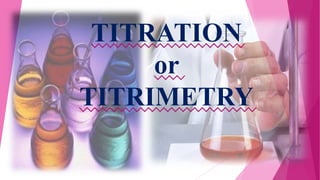Titration
•Download as PPTX, PDF•
0 likes•358 views
Titrimetric analysis and its types.
Report
Share
Report
Share

Recommended
Recommended
More Related Content
What's hot
What's hot (20)
Lecture-02.Classifications of Qualitative and Quantitative Analysis

Lecture-02.Classifications of Qualitative and Quantitative Analysis
Theory of Acid-base Indicators and Acid-base Titration Curves

Theory of Acid-base Indicators and Acid-base Titration Curves
Volumetric Analysis ( Titrimetric analysis) or Titration

Volumetric Analysis ( Titrimetric analysis) or Titration
Similar to Titration
Similar to Titration (20)
NCHE 211 UNIT 2 VOLUMETRY and Complexometry titration.pdf

NCHE 211 UNIT 2 VOLUMETRY and Complexometry titration.pdf
Titrimetric analysis of drugs based on 1) neutralization 2)Hydrolysis 3)Oxid...

Titrimetric analysis of drugs based on 1) neutralization 2)Hydrolysis 3)Oxid...
Recently uploaded
This presentation was provided by William Mattingly of the Smithsonian Institution, during the fourth segment of the NISO training series "AI & Prompt Design." Session Four: Structured Data and Assistants, was held on April 25, 2024.Mattingly "AI & Prompt Design: Structured Data, Assistants, & RAG"

Mattingly "AI & Prompt Design: Structured Data, Assistants, & RAG"National Information Standards Organization (NISO)
APM Welcome
Tuesday 30 April 2024
APM North West Network Conference, Synergies Across Sectors
Presented by:
Professor Adam Boddison OBE, Chief Executive Officer, APM
Conference overview:
https://www.apm.org.uk/community/apm-north-west-branch-conference/
Content description:
APM welcome from CEO
The main conference objective was to promote the Project Management profession with interaction between project practitioners, APM Corporate members, current project management students, academia and all who have an interest in projects.APM Welcome, APM North West Network Conference, Synergies Across Sectors

APM Welcome, APM North West Network Conference, Synergies Across SectorsAssociation for Project Management
God is a creative God Gen 1:1. All that He created was “good”, could also be translated “beautiful”. God created man in His own image Gen 1:27. Maths helps us discover the beauty that God has created in His world and, in turn, create beautiful designs to serve and enrich the lives of others.
Explore beautiful and ugly buildings. Mathematics helps us create beautiful d...

Explore beautiful and ugly buildings. Mathematics helps us create beautiful d...christianmathematics
Recently uploaded (20)
This PowerPoint helps students to consider the concept of infinity.

This PowerPoint helps students to consider the concept of infinity.
Basic Civil Engineering first year Notes- Chapter 4 Building.pptx

Basic Civil Engineering first year Notes- Chapter 4 Building.pptx
Seal of Good Local Governance (SGLG) 2024Final.pptx

Seal of Good Local Governance (SGLG) 2024Final.pptx
Measures of Central Tendency: Mean, Median and Mode

Measures of Central Tendency: Mean, Median and Mode
SECOND SEMESTER TOPIC COVERAGE SY 2023-2024 Trends, Networks, and Critical Th...

SECOND SEMESTER TOPIC COVERAGE SY 2023-2024 Trends, Networks, and Critical Th...
Mattingly "AI & Prompt Design: Structured Data, Assistants, & RAG"

Mattingly "AI & Prompt Design: Structured Data, Assistants, & RAG"
APM Welcome, APM North West Network Conference, Synergies Across Sectors

APM Welcome, APM North West Network Conference, Synergies Across Sectors
Explore beautiful and ugly buildings. Mathematics helps us create beautiful d...

Explore beautiful and ugly buildings. Mathematics helps us create beautiful d...
Titration
- 2. Qualitative Analysis: The chemical analysis designed to identify the components of a substance or mixture is called Qualitative Analysis of that substance. For example color is a qualitative property of the substance because it cant be quantified or simply measured in numbers.
- 3. Quantitative Analysis: Quantitative Analysis is the determination of the absolute or relative abundance( concentration) of one, several or all particular substance present in a sample. It can be done by gravimetric and volumetric analysis. Qualitative analysis tells what is the sample and quantitative analysis tells how much is present in a sample.
- 4. Titration: A technique for determining the concentration of a solution by measuring the volume of one solution needed to completely react with another solution. Typically, the titrant (the know solution) is added from a burette to a known quantity of the analyte (the unknown solution) until the reaction is complete.
- 5. Principle of Titration: It is based on the complete chemical reaction between the analyte and the reagent (titrant) of known concentration. Analyte + Titrant Product
- 6. Terms used in titration: Analyte: The solution of unknown concentration but known volume. Titrant: The solution of known concentration. Standard solution: A solution of known concentration . Types of Standard solution: 1. Primary standard: Pure, stable, can be weighed easily. Eg: Na2CO3 2. Secondary standard: Less pure, less stable, cannot be weighed easily. Eg:NaOH
- 7. Equivalence Point: Point where the amount of two reactants are just equivalent. End Point: Point at which the reaction is observed to be complete, this point is usually observed with the help of indicator. Indicator: An auxillary substance which helps in the usual detection of the completion of the titration process at the end point. Eg: Methyl orange, Phenolphthalein, Cresol red, Thymol blue. Concentration Terms: Molarity: Number of moles of a solute per liter of solution. Normality: Gram equivalent weight of the solute dissolved per liter of the solution. Molality: It is the number of moles of solute present in per kilogram of solvent.
- 8. Titrimetric calculation: It is based on the following law of equivalence: NaVa = NsVs or MaVa = MsVs
- 9. Titration of Mohr salt against potassium permanganate:
- 10. Types of Titrations: Acid base titrations Complexometric titrations Redox titrations Precipitation titrations
- 11. Acid-Base titration: A sample of unknown concentration of acid is estimated with a aknown concentrated base or vice versa. Acid + Base water + salt HCl + NaOH H2O + NaCl
- 12. Complexometric Titration: Titrant and Analyte react to form a complex till the end point is reached. Once the complex is formed the complex is stable and not further reaction reaction takes place. Redox Titration: Redox Titration is based on the redox reaction( oxidation- reduction) between analyte and titrant. Precipitation Titration: The titration which are based on the formation of the insoluble precipitates, when the solutions of the two reacting substances are brought in contact with each other are called Precipitation titration.